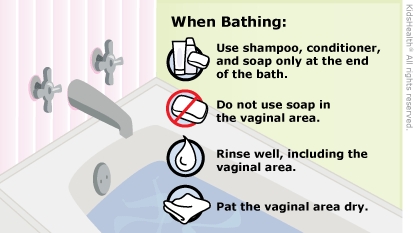Vaginitis is redness, soreness, or swelling in and around the vagina. The vulva (the area around the opening of the vagina) also might be irritated. Someone with vaginitis may feel itching, burning, or pain. Sometimes there is also a discharge (fluid) coming from the vagina.
Vaginitis is common in children of all ages. It usually gets better with simple home care.

Follow your health care provider's instructions for:
- If your child needs to use any ointments or medicines
- When to follow up
You can use the following tips to help your child feel better and heal:
- Have your child soak in the tub of plain (not soapy) warm water for 10–15 minutes with their legs spread so the water cleans the vaginal area. This can be done as many times as needed each day.
- If the vulva or vaginal area is sore or swollen, you can help your child put a cool, wet washcloth on the area for a few minutes every few hours, as needed.
- When taking a bath, your child should:
- Not use bubble bath.
- Use soap and shampoo at the end of the bath. This way they will not be sitting in water with soap or shampoo in it.
- Not wash the vaginal area with soap.
- Rinse off the vaginal area with plain water at the end of the bath.
- Pat the vaginal area dry with a clean towel when finished bathing.
- When showering, your child should:
- Not wash the vaginal area with soap.
- Rinse off the vaginal area with plain water at the end of the shower.
- Pat the vaginal area dry with a clean towel when finished showering.
- To help the irritation get better and to prevent vaginitis in the future, it may help to:
- Avoid tight clothing, such as tights, leotards, and leggings.
- Avoid sitting in a wet swimsuit for long periods of time.
- Wash underpants with a mild detergent without fabric softener, run through the rinse cycle twice to get all of the soap out, and dry without dryer sheets.
- Sleep in a nightgown or loose pajama pants without underpants so air can move freely around the vaginal area during sleep.
- Wear white cotton underpants.
- Wipe from front to back after urinating (peeing) or having a bowel movement (pooping).

What causes vaginitis? In young children, the lining of the vagina and the skin of the vulva are very thin. Soap, laundry detergent, fabric softener, tight clothing, wet diapers or swimsuits, sand, and germs can bother this area, leading to vaginitis.
Vaginitis also can happen when children don't clean themselves well after having a bowel movement (pooping). Getting a little piece of toilet paper stuck in the vagina or forgetting to remove a tampon also can lead to vaginitis.
If someone is sexually active, they may get vaginitis from latex condoms or spermicide (a chemical that prevents pregnancy by killing sperm). Vaginitis can sometimes be a sign of a yeast infection or a sexually transmitted infection (STI, also called sexually transmitted disease or STD).



